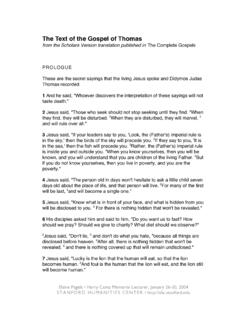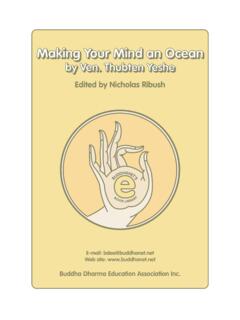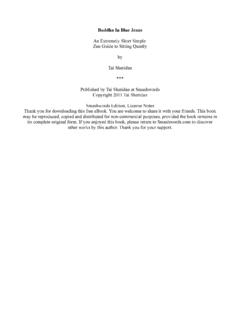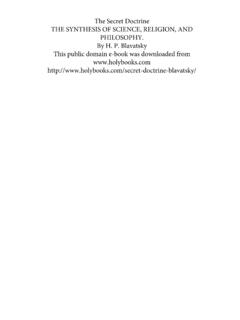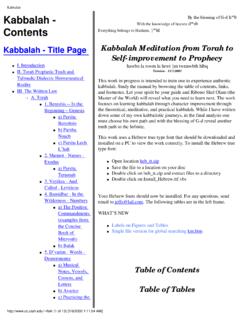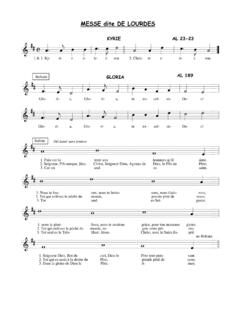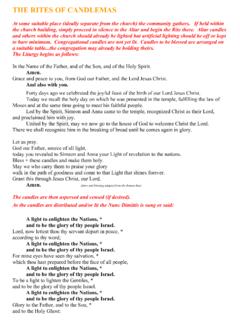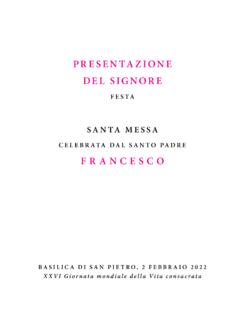Transcription of FRIEDRICH NIETZSCHE The Cay Science - holybooks.com
1 This free e-book has been downloaded from : TEXTS IN THE HISTORY OF PHILOSOPHY FRIEDRICH NIETZSCHE The Cay Science CAMBRIDGE TEXTS IN THE HISTORY OF PHILOSOPHY Series editor KARL AMERIKS Professor of Philosophy at the University of No tre Dame DESMOND M. CLARKE Professor of Philosophy at University College Cork The main objective of Cambridge Texts in the History of Philosophy is to expand the range, variety and quality of texts in the history of philosophy which are available in English. The series includes texts by familiar names (such as Descartes and Kant) and also by less well-known authors. Wherever possible, texts are published in complete and unabridged form, and translations are specially commissioned for the series. Each volume contains a critical introduction together with a guide to further reading and any necessary glossaries and textual apparatus. The volumes are designed for student use at undergraduate and postgraduate level and will be of interest not only to students of philosophy, but also to a wider audience of readers in the history of Science , the history of theology and the his tory of ideas.
2 Fora list of tit les pub lis hed in the series, please see end of book. FRIEDRICH NIETZSCHE The Cay Science With a Prelude in German Rhymes and an Appendix of Songs EDITED BY BERNARD WILLIAMS All Souls College, Oxford TRANSLA TED BY JOSEFINE NAUCKHOFF Wake Forest University POEMS TRANSLATED BY ADRIAN DEL CARO University o/Colorado at Boulder .. ~ .. CAMBRIDGE ::: UNIVERSITY PRESS CAMBRIDGE UNIVERSITY PRESS Cambridge, New York, Melbourne, Madrid, Cape Town, Singapore, Sao Paulo, Delhi Cambridge University Press The Edinburgh Building, Cambridge c B 2 8R u, UK Published in the United States of America by Cambridge University Press, New York Information on this tide: Cambridge University Press 2001 This publication is in copyright. Subject to statutory exception and to the provisions of relevant collective licensing agreements, no reproduction of any part may take place without the written permission of Cambridge University Press. First published 2001 Seventh printing 2008 Printed in the United Kingdom at the University Press, Cambridge A catalogue record for this publication is available from the British Library Library ofCongress cataloguing in publication data NIETZSCHE , FRIEDRICH Wilhelm, 1844-1900.
3 [Friihliche Wissenschaft. English] The gay Science : with a prelude in German rhymes and an appendix of songs I FRIEDRICH NIETZSCHE ; edited by Bernard Williams; translated by Josefine Nauckhoff; poems translated by Adrian Del Caro. p. cm. - (Cambridge texts in the history of philosophy) lncludes bibliographical references (p. ) and index. ISBN o 521 631599(hardback)-ISBN o 52163645o(paperback) r. Philosophy. I. Williams, Bernard Arthur Owen. 11. Nauckhoff,Josefine. III. Del Caro, Adrian, 1952-. IV. Tide. v. Series. ES 2001 193-dc21 2001025408 ISBN 978-0-521-63 I 59-4 hardback ISBN 978-0-521-63645-2 paperback Cambridge University Press has no responsibility for the persistence or accuracy ofURLs for external or third-party internet websites referred to in this publication, and does not guarantee that any content on such websites is, or will remain, accurate or appropriate. lntroduction Chronology Further reading Note on the text The Gay Science Contents 'Joke, Cunning and Revenge': Prelude in German Rhymes BookOne BookTwo Book Three Book Four: StJanuarius Book Five: We Fearless Ones Appendix: Songs of Prince Vogelfrei Index V page vii XXlll XXVl XXVll I II 27 69 109 157 199 249 Introduction The Cay Science is a remarkable book, both in itself and as offering a way into same of NIETZSCHE 's most important ideas.
4 The history of its publication is rather complex, and it throws same light on the develop-ment of his thought and of his methods as a writer. He published the first edition of it in 1882. In that version, it consisted of only four books, and had no Preface, though it did have the 'Prelude in Rhymes'. A second edition appeared in 1887, which added a fifth book, the Preface, and an Appendix of further poems. This is the work as we now know it, and which is translated here. Between the two editions of The Cay Science , NIETZSCHE wrote two of his best-known works, Thus Spoke Zarathustra (1883-5) and Beyond Cood and Evi/ (1886); the last section of Book Four of The Cay Science (342)1 is indeed virtually the same as the first section of Zarathustra. So the complete Cay Science brackets these two books, which are different from it and from each other. (Zarathustra, which is a peculiar literary experiment in a rhetoric drawn from the Bible, was once ane of NIETZSCHE 's most popular works, but it has worn less well than the others.)
5 Book Five of The Cay Science anticipates, in turn, same of the themes of another famous book which was to follow in 1887, On the Cenealogy of Morality, which is again different in tone, sustaining a more continuous theoretical argument. The Cay Science is a prime example of what is aften called NIETZSCHE 's 'aphoristic' style. It consists of a sequence of sections which are not obviously tied to ane another except, sametimes, in general content, and 1 References to The Cay Science , and to other works by NIETZSCHE , are to numbered sections. Vll lntroduction which do not offer a connected argument. The second half of Book Three, in particular, consists of many very short paragraphs of this kind. Elsewhere, however, there are longer passages, and in faet the arrangement of the shorter sections is not as fortuitous as it may look. It is often designed to gather thoughts which will, so to speak, circle in on some central theme or problem. In his earlier works, NIETZSCHE had moved gradually towards this style.
6 He had been appointed in 1869 as a professor of classical philology at the University of Basle, at the extraordinarily early age of twenty-four. He served in this position for ten years, resigning in 1879 because of the ill health which was to persist throughout his lif e. (The last letter he wrote, when in 1889 he broke down into insanity and a silence which lasted until his death in 1900, was to his distinguished colleague at Basle, Jacob Burckhardt, in which he said that he would rather have been a Swiss professor than God, but he had not dared to push egoism so far.) In his years at Basle he published first The Birth of Tragedy, which has the form, if not the content or the tone, of a treatise, and a set of four long essays collected as Untimely Meditations. In 1878-9 he brought out two books forming Human, All Too Human, followed in 1880 by a further part called 'The Wanderer and his Shadow', and in these writings he moved from continuous exposition and argument to setting out a sequence of thoughts which were not necessarily tied discursively to their neighbours, a style that allowed him to approach a question from many different directions.
7 In Daybreak, which came out in 1881, the style is fully developed. As late as 25 January 1882 he still referred to what were to be the first books of The Cay Science as a continuation of Daybreak; by June they had acquired their separate tide. When he made that decision, he sensed that Book Four, which is called 'Sanctus Januarius' and invokes the spirit of the New Year, might be found obscure, and he was anxious about whether his correspondent, Peter Gast, would understand it. He knew that this was not just a set of penetrating, perhaps rather cynical, aperrus. 'Aphorism', the standard term which I have already mentioned, implies too strongly that each is supposed to be a squib, or a compact expression of a truth (often in the form of an exaggerated falsehood) in the style of the French writers La Rochefoucault and Chamfort, whom NIETZSCHE indeed admired, but whom he did not simply follow in giving a self-conscious expose of some human failing, foible or piece of self-deception.
8 There is a certain Vlll lntroduction amount of that, particularly in the earlier books, but he was very aware of the risk that such aphorisms run of sliding from the daring through the knowing to the self-satisfied (it is not merely cynicism that he intends when he says in 379 that 'we are artists of contempt'). His ambitions are deeper; the effect is meant to be cumulative, and its aim is more systematically subversive. A philosopher who had a similar inten-tion, though in totally different connections, is the later Wittgenstein, and NIETZSCHE might have called the sections of this book, as Wittgen-stein called the paragraphs of his manuscripts, 'remarks'. His remarks cover very various subjects. Many of them touch on what may be called moral psychology, and sometimes he does claim to detect an egoistic origin of some ethically approved reaction (as he does, for example, in the shrewd observation about magnanimity and revenge at section 49). The search for the 'shameful origin' of our moral senti-ments was later to become an important principle of his genealogical method.
9 But he is very clear that mere reductionism, the readily cynical explanation of all such attitudes in terms of self-interest, is a mistake. Partly this is because he does not think that self-interest is an indivi-dual's basic motive anyway, and this book contains some quite complex, if unresolved, reflections on that question, in particular when he considers whether the virtues have a value for the individual who possesses them, or for the group. But, more broadly, NIETZSCHE thinks that the reductive spirit itself can be in error, a form of vulgarity (3), and that the 'realists' who congratulate themselves on having the measure of human unreason and self-deception are usually themselves in the grip of some ancient fantasy (57). Above all, it is simply not enough, in NIETZSCHE 's view, to 'unmask' some supposedly honourable sentiment or opinion and leave it at that. 'Only as creators can we destroy', he very significantly says (58). What things are called is fundamentally important, but a conventional set of names -as we may say, an interpretation -can be replaced only by another, more powerful, interpretation.
10 When we say that one inter-pretation is more powerful than another, it is vitally important what counts as 'power'. It is often said that NIETZSCHE explains everything in terms of power. This says something about the way in which he saw these problems, but it is wrong if it is supposed to state his solution to it. The point is very clear in On the Genealogy of Morality. There he tells a story of how a certain outlook or interpretation, embodying IX lntroduction metaphysical illusions, came into existence as a psychological compensa-tion for the weakness of people who were powerless, and how this oudook triumphed over the conventionally strong and their view of the world. The question must be, how could this have come about? What was the source of this new power? There had to be something to this new way of describing the world which accounted in naturalistic terms for its triumph, and NIETZSCHE fully accepts this, even if he does not have a very rich vocabulary of social explanation in which he can discuss what it might be.



